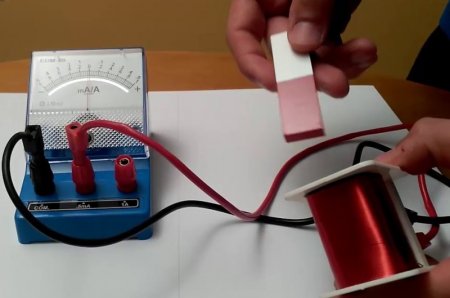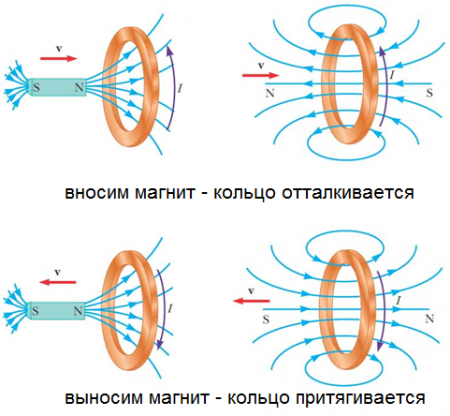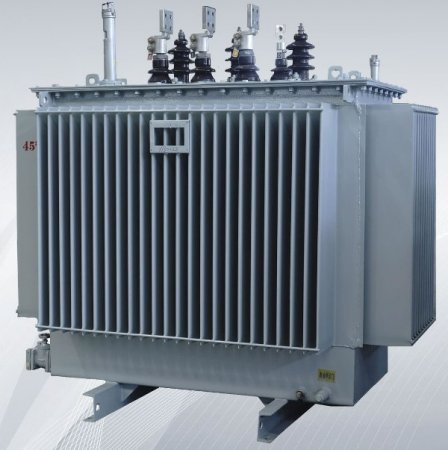Definition and explanation of Lenz's rule
Lenz's rule allows you to determine the direction of the induction current in the circuit. He says: «the direction of the induction current is always such that its action weakens the effect of the cause causing this induction current».
If the trajectory of a moving charged particle changes in any way as a result of the particle's interaction with a magnetic field, then these changes lead to the appearance of a new magnetic field, exactly opposite the magnetic field that caused these changes.
For example, if you take a small copper ring suspended by a thread and try to drive into it with the north pole strong enough magnet, once the magnet approaches the ring, the ring will start to repel the magnet.
It seems that the ring begins to behave like a magnet, facing the same name (in this example, the north) pole to the magnet inserted into it, and thus tries to weaken the so-called magnet.
And if you stop the magnet in the ring and start pushing from the ring, then the ring, on the contrary, will follow the magnet, as if it manifests itself as the same magnet, but now - facing the opposite pole to the pull - output magnet (we move the north pole of the magnet - the south pole formed on the ring is attracted), this time trying to strengthen the magnetic field weakened due to the expansion of the magnet.
If you do the same with an open ring, then the ring will not respond to the magnet, although an EMF will be induced in it, but since the ring is not closed, there will be no induced current and therefore its direction does not need to be determined.
What is really going on here? By pushing a magnet into a complete ring, we increase the magnetic flux penetrating the closed loop, and therefore (from according to Faraday's law of electromagnetic inductionEMF generated in the ring is proportional to the rate of change of the magnetic flux) EMF is generated in the ring.
And by pushing the magnet out of the ring, we also change the magnetic flux through the ring, only now we do not increase it, but decrease it, and the resulting EMF will again be proportional to the rate of change of the magnetic flux, but directed in the opposite direction. Since the circuit is a closed ring, the EMF of course generates a closed current in the ring. And current creates a magnetic field around itself.
The direction of the induction lines of the magnetic field generated in the current ring can be determined by the gimlet rule, and they will be directed precisely in such a way as to prevent the behavior of the induction lines of the introduced magnet: the lines of an external source enter the ring, and from the ring, respectively, the lines of an external source leave the ring, respectively, in the ring, they go.
Lenz's rule in a transformer
Now let us recall how, in accordance with Lenz's rule, it is loaded mains transformer… Suppose the current increases in the primary winding of the transformer, therefore, the magnetic field in the core increases. The magnetic flux penetrating the secondary winding of the transformer increases.
Since the secondary winding of the transformer is closed by the load, the EMF generated in it will generate an induced current, which will create its own magnetic field on the secondary winding. The direction of this magnetic field will be such that it weakens the magnetic field of the primary winding. This means that the current in the primary winding will increase (since an increase in the load in the secondary winding is equivalent to a decrease in the inductance of the primary winding of the transformer, which means reducing the impedance of the mains transformer). And the network will start doing work in the primary winding of the transformer, the value of which will depend on the load in the secondary winding.



